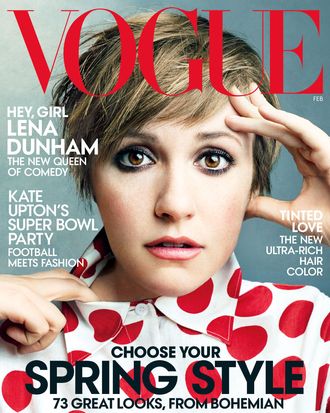
Yesterday Jezebel offered a $10,000 for an unretouched photo of Lena Dunham’s Vogue shoot. It was a remake of the 2007 stunt that put the site on the map: Back then, founding editor Anna Holmes offered the same cash reward for the original version of any women’s-magazine cover image from the past two years, a bounty hunt that yielded a Faith Hill Redbook cover in which the singer still had bags under her eyes.
In 2007, it took two months for Jezebel to make the big reveal; this time (according to Coen), they got the pictures within two hours. As with the Redbook cover, the differences they revealed were minor tweaks — filled-out eyebrows, a shaded jawline, a digital haircut on the cover. Inside, Dunham’s cleavage was covered up, a leg was lengthened, and — the big reveal — she was shown not wearing that pigeon fascinator. Coen acknowledged the anti-climax: “While Dunham has not been radically Photoshopped, it’s clearer than ever what kind of woman Vogue finds Vogue-worthy: The taller, longer-limbed, svelter version of reality.” Which only left us with the same question we’d had when they first announced the bounty: What had Jezebel intended to accomplish?
Specifically targeting Dunham in Vogue made it sound a lot like they hoped to reveal how many pounds Dunham lost on the Vogue diet. (The answer: not many.) Jezebel editor Jessica Coen had tried to preempt this criticism — she’d pointed out that the reward couldn’t be about revealing what Dunham “really” looks like, because we can see that on TV every Sunday night. Instead, she said, this was about Vogue, and figuring out just how “resistant” the magazine is to the idea that a Dunham likes herself fine the way she is.
But the answer here was obvious all along: Vogue is 100 percent “resistant” to that idea. As in, they retouch all women, regardless of their weight, beauty, self-esteem, or net worth. Their images are creative nonfiction, not journalism. And calling attention to how much Vogue might have altered this particular woman (as opposed to ANY woman, as in 2007) only served to underscore what Jezebel took to be that woman’s obvious distance from the messed-up ideal the site ostensibly hoped to take down. In 2007, the surprise of Jezebel’s Redbook coup was that trying to look like Faith Hill on the cover of a magazine is a trap. Not even Real Human Faith Hill looks like Faith Hill on the cover of a magazine. The surprise of this was — what, exactly? Dunham’s persona and ideas ARE at odds with Vogue’s images. But that incongruity is about Vogue’s aesthetic. And Jezebel’s $10,000 challenge didn’t make the issue Vogue’s aesthetic; it made the issue Dunham’s body.
Besides, since Jezebel’s launch, the unretouched-image game has spread to outlets driven more by voyeurism than idealism. Schadenfreude drives more clicks than concern for body image or impressionable teens. As Amanda Fortini wrote in 2010:
“The endless cavalcade of before-and-after shots is an outgrowth of the voyeurism, gossipmongering, and schadenfreude that fuel our celebrity industrial complex. People want to see actresses in all their wrinkled, full-figured glory for the same reason they want to purchase tabloids replete with pictures of A-list love handles. They want assurance that stars are just like us, which is to say imperfect.”
Which gets at the other big difference between this campaign and 2007’s. Seven years later, Photoshop literacy is vastly improved and teenage girls about as likely to stumble across a Jezebel link as a Vogue cover. Thanks in no small part to Jezebel, they launch their own grassroots campaigns against Photoshopping in magazines. In fact, I think many people saw Vogue’s decision to put Dunham on the cover as a sign that the magazine is now chasing a conversation that has since moved elsewhere, to Jezebel and other sites that were founded, partly, in opposition to Vogue and its Photoshopping fashion-magazine ilk. Which makes it time for Jezebel to take up a new cause.
This post has been updated throughout.




